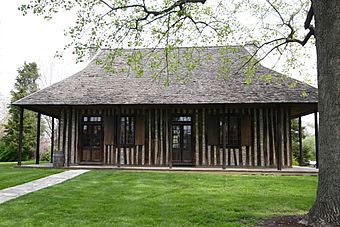Old Cahokia Courthouse facts for kids
The Cahokia Courthouse State Historic Site is a very old building in Cahokia Heights, Illinois. It was first built around 1740. This special building has been both a home and a place where important court cases were decided.
Today, it looks like it did around the year 1800. Back then, it was a courthouse for the Northwest Territory. This was a large area of land that later became states like Illinois. The courthouse was added to the National Register of Historic Places on November 9, 1972. This means it's a very important historical place.
The old log home in Cahokia is thought to have been built in 1737. It was a four-room house for a family. Later, a man named Jean Francois Saucier owned it. His first six children were born there. This building is believed to be the oldest house in Illinois and even in the Midwest!
Contents
French Settlers in the Mississippi Valley
After explorers like Marquette, Jolliet, and La Salle explored the Mississippi Valley in the 1670s, this area became part of New France. The French explored a lot of land. They soon focused on a rich area south of the Missouri River. This area is now called the American Bottom. Its soil was very good for farming. The local Native Americans, called the Illiniwek, were friendly to the French.
French Villages and Homes
In the early 1700s, French-speaking people, mostly from Canada, settled villages in the American Bottom. Some of these villages were Kaskaskia, Prairie du Rocher, and Cahokia. The French lived peacefully with the Native Americans. They even named some villages, like Cahokia, after the local tribes.
The building we now call the Cahokia Courthouse started as a French-Canadian log cabin. It was built by an unknown settler around 1740. French builders had a special way of building. They placed logs vertically, standing them upright. This was different from how English settlers built, who placed logs horizontally. This French style is called poteaux-sur-sol. It means "posts on sill." This method helped protect the wood from rotting.
The American Bottom After the Revolution
After the American Revolution and the Treaty of Paris in 1783, the Cahokia area became part of the new United States. Before this, it was controlled by Great Britain. The fertile land east of the Mississippi River became known as the American Bottom. This helped tell it apart from the west side of the river, which was a Spanish colony at the time.
Cahokia Becomes a Courthouse
American settlers wanted to govern themselves. They spent a lot of effort setting up local governments and laws. On April 27, 1790, St. Clair County, Illinois, was formed. It was the first county in the Illinois region of the Northwest Territory. Soon after, the old Cahokia house, which was very well-built, became the courthouse for this new county.
This small building was where important decisions were made. People registered land titles and transfers there. Businesses like frontier taverns and ferryboats needed licenses from this building. Criminal cases were heard, and votes were counted.
By 1804, many more settlers came to Illinois. The federal government opened its first land office in Kaskaskia to sell land. St. Clair County grew too big for the small log cabin to be a courthouse anymore.
Moving and Rebuilding the Courthouse
In 1904, people planning the St. Louis World's Fair found the old Cahokia courthouse. It was one of the oldest buildings left in Illinois. They bought it, took it apart, and moved the wooden pieces across the river to St. Louis. They rebuilt it there as an attraction for the fair.
The courthouse survived this move and made people in Illinois very interested. After the fair, the cabin was taken apart again. In 1906, it was rebuilt in Jackson Park in Chicago.
People in Cahokia were not happy that their oldest building was moved so far away. In the 1920s, they worked hard to get the old log cabin bought and rebuilt a third time. This time, it was put back on its original spot.
However, by this time, very little of the original 1740 cabin was left. Each time it was taken apart and rebuilt, many of the old wooden pieces were replaced with new ones. So, the third rebuilding was mostly a new building. The state of Illinois said that the rebuilt Cahokia courthouse still had some pieces of wood from the very first structure.
Visiting the Courthouse Today
The rebuilt Cahokia Courthouse is an important historic site in Illinois. It is one of the oldest in the United States. Since 1985, it has been managed by the Illinois Historic Preservation Agency (IHPA).
When you visit, you can learn about the court cases and issues handled there around 1800. You can also learn about how the building was moved around. There is a visitor center with exhibits about the French settlers in the 1700s. You can also learn about the nearby Nicholas Jarrot Mansion.
Due to state budget cuts, the Cahokia Courthouse was temporarily closed to the public from December 2008 until April 2009.






